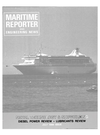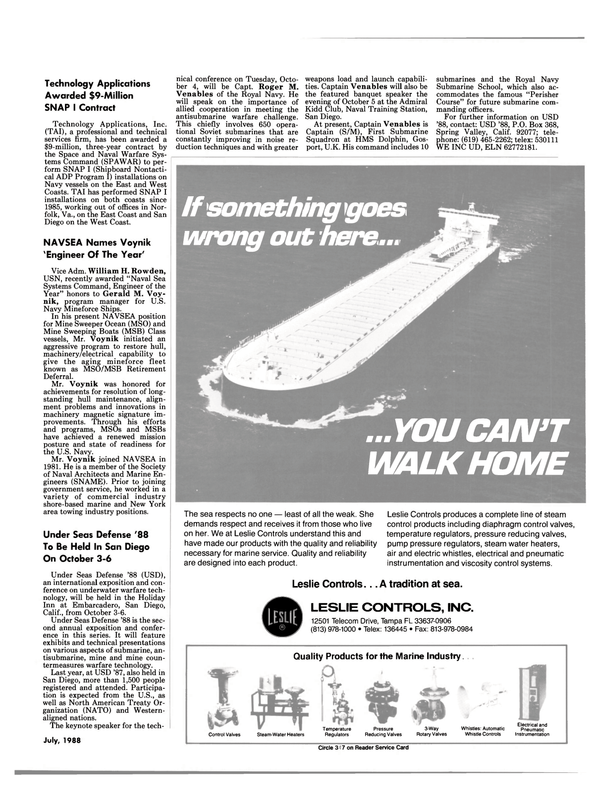
BUSINESS OPPORTUNITIES IN THE NEW NAVAL TECHNOLOGY PROGRAM
Over the next two years the U.S.
Navy will spend more than $18 billion on developing new systems and equipment. The program offers many exciting business opportunities for manufacturers, engineering firms, systems integrators, etc.
Spending Is Up For New Technology Navy R&D spending has grown impressively over the past 10 years.
In 1980, the Navy spent $4.6 billion for R&D. This figure has now more than doubled—to $9.5 billion in 1988 and $9.2 billion in 1989. Exhibit 1, "Trend in the Navy R&D Budget," provides details on Navy R&D spending from 1980-1989.
Range of Technology Development Navy technology development ef- forts range from the highly esoteric to the very practical. They include development of sensors for anti-air and antisubmarine warfare, C3 systems for command and control, ship and naval aircraft development, missile and torpedo engineering, electronic warfare concepts, etc.
Some of the most advanced technology is being developed—advanced composites, parallel computing, laser communications, distributed control systems, etc. And some of the more mature technology is being refined—hull forms, propeller design, mines, electric drive, navigation systems, etc.
Program Structure There are more than 270 Navy R&D programs—grouped according to stage of development: • 6.1 and 6.2 programs involve research and exploratory development; • 6.3 programs deal with advanced development; • 6.4 programs focus on system and component engineering.
Projects usually enter the system at the 6.1 or 6.2 level, transition to 6.3 when found feasible and move to 6.4 engineering as the final R&D stage. Transition into the procurement budget (SCN, WPN or OPN) follows successful test and demonstration.
Funding requirements generally increase dramatically as a project moves through this development/ production pipeline. Exhibits 2 and 3 depict project transition and a typical funding profile.
Business Strategy Successful Navy contractors have often been involved in early stages of system R&D. For example: • RCA traces its highly successful role as Aegis manufacturer and system integrator to involvement in R&D efforts in the 1960s. Procurement contracts received by RCA for Aegis systems now exceed $3 billion.
• Boeing's involvement in the Sea Lance stand-off weapon can be traced back many years to its role in early exploratory research.
• Martin Marietta's development role in vertical launch system design led to its current position as one of two VLS suppliers.
• GE's early and sustained involve- ment in sonar sensor R&D has positioned the firm as dominant sonar system supplier.
What distinguishes these firms is their use of the Navy funded R&D to: (1) establish initial position; (2) widen and deepen technical development; (3) evolve into a key developer role; and (4) transition into full production as sole source or lead manufacturer.
Opportunities exist for both large and small firms to employ similar strategy for future business development— using Navy R&D as the vehicle. This strategy entails: (1) developing an understanding of future R&D programs; (2) matching the firm's capabilities with these programs; (3) measuring the competition; (4) shortlisting programs and areas of interest; and (5) formulating and implementing a plan of action for initial entry and growth.
Entry can be either at prime or subcontract level. Contact with Navy managers in key activities will provide the basis for identifying prime contract opportunities. Contact with current prime contractors will provide the basis for establishing a position as subcontractor.
To illustrate the nature and extent of opportunities in Navy technology, one area—underwater sound surveillance systems—is described as detailed from an IMA Report.
Underwater Sound Surveillance Systems The concept of planting listening devices on the ocean floor dates from WWII. After the war, the Navy began development of deep ocean arrays of hydrophones designed to listen for submarines. Since then, a number of sound surveillance system (SOSUS) arrays have been placed in position off the U.S. coast and in overseas locations.
The IUSS program (PE 24311) is designed to improve underwater surveillance systems and hardware.
Specific work includes: (1) software development for the Wide Band Acoustic Recall; and (2) development of prototype signal characterization algorithms.
FDS (PE 63784) is a major development program to design and install an advanced undersea surveillance system using fiber optic technology employing a large number of sensors in fields or barriers. Development efforts build on Bell Laboratories' experience in commercial fiber optic communications systems.
Work involves development of multiplexer/sensor hardware, modified cable handling equipment and improved deployment technique.
Future Direction Major IUSS milestones include sea trials in October 1989 and system EDM specification in September 1990. DNSARC IIA for the FDS was scheduled in May 1988. Prototype production is planned to start in July 1989. Final design specifications are to be completed by April 1990. Procurement plans call for 7,150 NM cable, 200 clusters, 205 multiplexers/repeaters and 339 repeaters by 1992.
Comments and Issues Advances in quieting technology have greatly reduced the effectiveness of on-board listening devices.
Offboard ASW sensors are a high priority element in the Navy's future ASW strategy. Development of the IUSS will expand on existing SOSUS capability. In the longer term, the Navy hopes to develop and deploy the FDS and plans to spend almost $700 million on FDS RDT&E through program completion.
How to Order IMA's Full Report on Naval Technology A recently published report by IMA provides details for 204 specific naval technology development activities.
Current and planned efforts are described. Navy managers and current key contractors are named.
A five-year funding profile from FY 1985 through 1989 is provided for each program. Issues affecting future spending are discussed.
The report contains a four-year history of major Navy technology development and engineering contracts.
These contracts are arranged in alphabetical order according to contractor. The period covered extends from January 1984 through December 1987.
Organization charts and names of key personnel in 13 commands or laboratories involved in naval technology development are provided.
The 220-page report is available for $550. It can be obtained by contacting: International Maritime Associates, Inc., 835 New Hampshire Avenue, N.W., Washington, D.C.
20037; telephone: (202) 333-8501.
Telephone orders will be accepted.
Read BUSINESS OPPORTUNITIES IN THE NEW NAVAL TECHNOLOGY PROGRAM in Pdf, Flash or Html5 edition of July 1988 Maritime Reporter
Other stories from July 1988 issue
Content
- Stolt-Nielsen Buys Out Oiltanking's Interest In Houston Storage Terminal page: 4
- Curtis Bay Towing Changes Name page: 6
- Arthur Engel Chosen Maritime Man Of The Year page: 6
- General Thermodynamics Offers Free Literature On 300-A BMEP Balancer page: 6
- Wartsila Marine-Turku Delivers 1,800-Passenger Cruise Ship To Norwegian Cruise Line page: 7
- Watercom Names Gerald A. Motta VP, Operations page: 7
- SPD Technologies Acquires Brown Boveri Switchgear Unit page: 8
- Soundcoat Introduces Four Lightweight Vibration Damping Materials page: 9
- DIESEL POWER REVIEW page: 10
- SNAME To Hold 1988 Ship Production Symposium In Seattle, August 24-26 page: 24
- Burmeister & Wain Christens Panamax Product Tanker page: 26
- MMS Brochures Detail Cost-Cutting Ship And Shore Management Systems page: 28
- Nichols Brothers Boat Builders Delivers 500-Passenger Catamaran page: 28
- BUSINESS OPPORTUNITIES IN THE NEW NAVAL TECHNOLOGY PROGRAM page: 31
- House Subcommittee Looks To Open Competition To Build Fourth Aegis Destroyer page: 33
- Marinette Marine Delivers First Of Seven Training Vessels page: 33
- MAJOR NAVY CONTRACTS page: 36
- Under Seas Defense '88 To Be Held In San Diego On October 3-6 page: 43
- Kelly Klosure Units Used By General Ship In Navy Renovation Work page: 44
- Marine Machinery Association Holds Government-Industry Forum On Ship Repair And Parts Quality page: 45
- Equitable Reopens Louisiana Shipyard To Build Coal Barges page: 49
- MarineSafety Awarded Los Angeles Port Study page: 50
- MARINE LUBRICANTS MEETING THE DEMANDS OF NEW AND UPGRADED DIESELS page: 52
- New 12-Page PBM Catalog On Multi-Port Ball Valves page: 63
- Ameron Marine Coatings Offers High-Performance Products For Steelwork Protection page: 63
- Established Canadian Firm Designs And Builds Innovative Vessels And Marine Equipment page: 63
- American Heavy Lift Names Admiral Peet To Board of Directors page: 64


